ALTERNATIVE FACTS
Eugene O’Neill is one of those gigantically influential artists whom it is often difficult for later generations to enjoy. The innovations he cribbed from Ibsen and Chekhov can feel very dated now; they were a throwback even in 1956, when contemporary critics saw past the mean realism of Long Day’s Journey into Night to recognize something refreshingly Greek. But to see characters explicated in terms of their psychological underpinnings is simply not show enough, now, for some of us. Characters, it is held in certain quarters, ought to do something, if not in the text at least in the manner of its presentation.
Because O’Neill was the first realist in America, he is often revived realistically, in homage to the inaugural flexing of our own theatrical muscles. But this kind of staging, period piece as re-enactment, rarely works because the plays are robbed of their original, largely contextual impact. The attraction, in something like 1921’s Anna Christie, was less in its tawdry story than in the novel manner of its attempt to represent life more or less as it really happens most of the time. In 2017, it is no novelty to be reminded that ordinary shit happens.
And though it is the literary grandfather of big American family dramas – from Cat on a Hot Tin Roof to Who’s Afraid of Virginia Woolf? to Curse of the Starving Class to August: Osage County – Long Day’s Journey is, on paper, by far the least interesting. In this play, the family of an aged actor idles in a parlor from one morning to the next, attacking each other overtly and unconsciously, lying to each other in the way that families do, telling fables to the last people in the world likely to believe them. James is a bullying miser; Mary a depressive morphine addict; James Jr. a worthless alcoholic; Edmund a consumptive laborer and failed poet. Occasionally a maid comes on to tell a joke. Four acts of this is more than sufficient time to get the point; one act is enough for that. And so it is in the manner of the telling that the story must succeed.
Characters in this text are constantly telling each other to sit down and have a drink, and if they do, the show is doomed. There are too many iterations of each monologue, too many reveals of each revelation; it is too much a character study, with not nearly enough dramatic action or surprise, for a satisfying piece of stage realism today. (Sidney Lumet proved in 1962 that the script is, however, perfect for film.)
All three and a half hours of Long Day’s Journey can be great fun, and very powerful, when it’s directed with style enough to flesh out what Thomas Dash admitted (in his 1956 rave for Women’s Wear Daily) is a text that “meanders exasperatingly.” There was a vogue, in the latter half of the last century, for filling the Long Day’s Journey stage with an abundance of machine-made mist to match the fog referred to incessantly in the text, so that by the end, both the interminable speeches and the foghorn that interrupts them emerged from the same gray soup. In 1986, Jonathan Miller cut a half-hour off the running time by making Jack Lemmon talk over the other actors. I miss the days when big revivals relied on theatricality, and counted on their audiences’ competence to absorb a non-realistic narrative (and on their text’s ability to support it).
Jeanie Hackett’s staging, now up at the Geffen’s 600-seat venue, seems both traditionally realistic and pitched for a much larger house. Tom Buderwitz’s set is grand and useful, flanked by screens projected with that famous fog (video by Jason H. Thompson). Occasionally, bafflingly, photographs of O’Neill swirl in the fog, and O’Neill’s voice can be heard at the top of the show, reciting the Swinburne poem debated in the play (sound design by Michael Roth). This seems solipsistic; O’Neill belongs on this stage, should come over these speakers, because he wrote the play? Is the audience to get a deeper appreciation from this reminder that the play is autobiographical?
It’s a choice clearly related to the one that has Edmund (O’Neill’s stand-in for himself) creep onto the set at the top, a ghost wandering his own memories. But this device is dropped with the first line of dialogue. After that, aside from a couple of nice discoveries (Jane Kaczmarek and Angela Goethals have a good one during their tipsy scene), it’s all unrelieved speechmaking.
The performances are loud and large, the movement good, the stage pictures handsome. But the pacing is lethargic, the scenes as incremental, episodic and redundant as on the page. And the actors, all of them very good, seem mostly miscast. When a stage full of excellent talents spend most of their time yelling desperately, even when they’re whispering, I usually attribute the problem to casting and insufficient rehearsal time. In a show like this, there’s a lot of work to be done only after the lines have been learned, and that’s a lot of lines.
Goethals plays the maid broadly and with good timing. As James Jr. and Edmund, Stephen Louis Grush and Colin Woodell are attractive and forgettable, lost in a fog of syllables. Kaczmarek is a wonderful actor but an odd choice for O’Neill’s junkie matriarch; her Mary Tyrone has neither the epic tragedy of a Jessica Lange nor the viciousness of a Colleen Dewhurst. She is a rather general junkie, twitchy and flighty, her eyes scared, her voice a-tremble. It is an impossible role to play generally; like Hamlet, like any character who doesn’t do very much but spends a lot of time talking, Mary must be played with enormous specificity.
As James, Alfred Molina is less befogged but still looks uncomfortable as a matinee idol. I hope the actor will forgive me, but in this role his physicality and voice reminded me repeatedly of the current president of the United States, a blustering salesman well-versed in talking without saying anything. Molina trumps his fellows here at conveying the sad insanity of repeating lies until one believes them. Now how about a version of Long Day’s Journey set in the White House?
photos by Chris Whitaker
Long Day’s Journey into Night
Gil Cates Theater at the Geffen Playhouse
10866 Le Conte Avenue in Westwood
Tues-Fri at 8; Sat at 3 & 8; Sun at 2 & 7
ends on March 18, 2017
for tickets, call 310.208.5454 or visit Geffen Playhouse
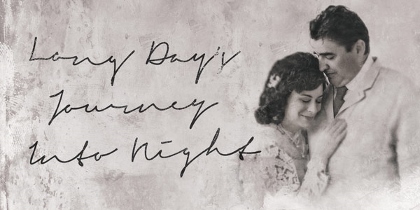

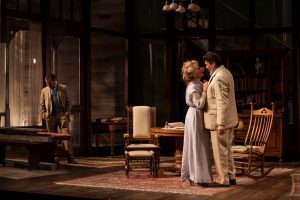
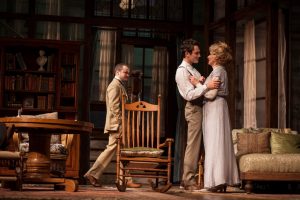
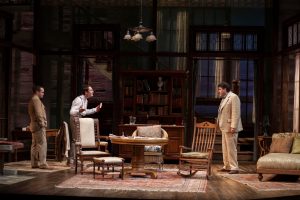
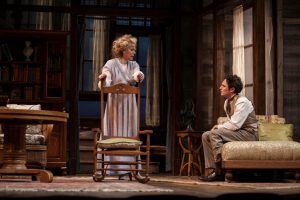

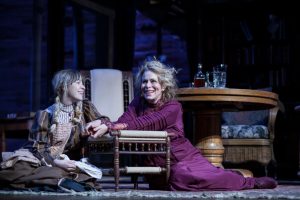
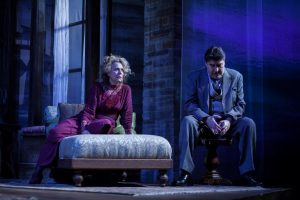

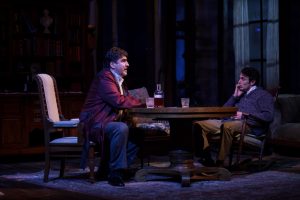
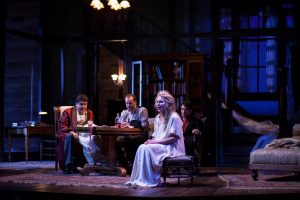

{ 1 comment… read it below or add one }
I saw the play on Feb. 17th. I’d seen Molina in Red at the Mark Taper Forum and wanted to see him in action here, so I drove down from Salt Lake City. Perhaps, since I’m a columnist, I revel more than others in language-driven plays. Off the cuff, I felt Mary displayed too much frenzy. (I kept seeing Joan Crawford). But Molina, for me, didn’t disappoint. He was smooth and slick (as a former matinee idol would be) but also he could erupt with chest pounding and high drama. (Was he channeling his own father?) When James Sr. gets his “Irish” up Molina certainly gets his “Latin” up. I could feel the barometer rise whenever he rose to speak. I’d drive down to see him again — in this, or (hint) maybe in something more ethnic, like Lorca’s Blood Wedding.